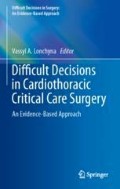Abstract
The finding of free air on postoperative imaging creates a difficult scenario for the clinician triggering immediate action. A quick decision needs to be made to determine whether the free air is related to a GI perforation and whether surgical intervention is required. In select cases, some patients can undergo expectant observation. There have been numerous studies both retrospective and prospective, attempting to determine the incidence, duration, and characteristics of “benign,” postoperative pneumoperitoneum. Overall, the duration of a benign postoperative pneumoperitoneum can vary greatly but often tends to reabsorb within 1–2 weeks and is usually of a small volume. It is also important to remember that CT scans are much more sensitive for picking up free air than plain films so the finding of “benign” free air on a postoperative CT scan is much more likely than on plain films. The most important general conclusion from the literature is that there is a percentage of patients with free air found on imaging that can be observed; however, observing for, and consideration of surgical peritonitis should be an ongoing concern and continuously reassessed.
Access this chapter
Tax calculation will be finalised at checkout
Purchases are for personal use only
References
Harrison I, Litwer H, Gerwig WH Jr. Studies on the incidence and duration of postoperative pneumoperitoneum. Ann Surg. 1957;145(4):591–4.
Brandl A, Kratzer T, Kafka-Ritsch R, et al. Diverticulitis in immunosuppressed patients: a fatal outcome requiring a new approach? Can J Surg. 2016;59(4):254–61.
Lagercrantz E, Lindblom D, Sartipy U. Survival and quality of life in cardiac surgery patients with prolonged intensive care. Ann Thorac Surg. 2010;89(2):490–5.
Turrentine FE, Wang H, Simpson VB, Jones RS. Surgical risk factors, morbidity, and mortality in elderly patients. J Am Coll Surg. 2006;203(6):865–77.
Milone M, Di Minno MN, Bifulco G, et al. Diagnostic value of abdominal free air detection on a plain chest radiograph in the early postoperative period: a prospective study in 648 consecutive patients who have undergone abdominal surgery. J Gastrointest Surg. 2013;17(9):1673–82.
Earls JP, Dachman AH, Colon E, Garrett MG, Molloy M. Prevalence and duration of postoperative pneumoperitoneum: sensitivity of CT vs left lateral decubitus radiography. AJR Am J Roentgenol. 1993;161(4):781–5.
Gayer G, Jonas T, Apter S, Amitai M, Shabtai M, Hertz M. Postoperative pneumoperitoneum as detected by CT: prevalence, duration, and relevant factors affecting its possible significance. Abdom Imaging. 2000;25(3):301–5.
Chapman BC, McIntosh KE, Jones EL, Wells D, Stiegmann GV, Robinson TN. Postoperative pneumoperitoneum: is it normal or pathologic? J Surg Res. 2015;197(1):107–11.
Malgras B, Place V, Dohan A, et al. Natural history of pneumoperitoneum after laparotomy: findings on multidetector-row computed tomography. World J Surg. 2017;41(1):56–63.
Feingold DL, Widmann WD, Calhoun SK, et al. Persistent post-laparoscopy pneumoperitoneum. Surg Endosc. 2003;17(2):296–9.
Draper K, Jefson R, Jongeward R Jr, McLeod M. Duration of postlaparoscopic pneumoperitoneum. Surg Endosc. 1997;11(8):809–11.
Solis CV, Chang Y, De Moya MA, Velmahos GC, Fagenholz PJ. Free air on plain film: do we need a computed tomography too? J Emerg Trauma Shock. 2014;7(1):3–8.
Stapakis JC, Thickman D. Diagnosis of pneumoperitoneum: abdominal CT vs. upright chest film. J Comput Assist Tomogr. 1992;16(5):713–6.
Soreide K, Thorsen K, Harrison EM, et al. Perforated peptic ulcer. Lancet. 2015;386(10000):1288–98.
Crofts TJ, Park KG, Steele RJ, Chung SS, Li AK. A randomized trial of nonoperative treatment for perforated peptic ulcer. N Engl J Med. 1989;320(15):970–3.
Buck DL, Vester-Andersen M, Moller MH. Danish clinical register of emergency S. Surgical delay is a critical determinant of survival in perforated peptic ulcer. Br J Surg. 2013;100(8):1045–9.
Sallinen VJ, Mentula PJ, Leppaniemi AK. Nonoperative management of perforated diverticulitis with extraluminal air is safe and effective in selected patients. Dis Colon Rectum. 2014;57(7):875–81.
Langell JT, Mulvihill SJ. Gastrointestinal perforation and the acute abdomen. Med Clin North Am. 2008;92(3):599–625, viii–ix.
De’Angelis N, Esposito F, Memeo R, et al. Emergency abdominal surgery after solid organ transplantation: a systematic review. World J Emerg Surg. 2016;11(1):43.
Larson ES, Khalil HA, Lin AY, et al. Diverticulitis occurs early after lung transplantation. J Surg Res. 2014;190(2):667–71.
Beaver TM, Fullerton DA, Zamora MR, et al. Colon perforation after lung transplantation. Ann Thorac Surg. 1996;62(3):839–43.
Reshef A, Stocchi L, Kiran RP, et al. Case-matched comparison of perioperative outcomes after surgical treatment of sigmoid diverticulitis in solid organ transplant recipients versus immunocompetent patients. Color Dis. 2012;14(12):1546–52.
Blum CA, Selander C, Ruddy JM, Leon S. The incidence and clinical significance of pneumoperitoneum after percutaneous endoscopic gastrostomy: a review of 722 cases. Am Surg. 2009;75(1):39–43.
Nazarian A, Cross W, Kowdley GC. Pneumoperitoneum after percutaneous endoscopic gastrostomy among adults in the intensive care unit: incidence, predictive factors, and clinical significance. Am Surg. 2012;78(5):591–4.
Alley JB, Corneille MG, Stewart RM, Dent DL. Pneumoperitoneum after percutaneous endoscopic gastrostomy in patients in the intensive care unit. Am Surg. 2007;73(8):765–7; discussion 768
Kiefer T, Schenk U, Weber J, Hubel E, Kuhlmann U. Incidence and significance of pneumoperitoneum in continuous ambulatory peritoneal dialysis. Am J Kidney Dis. 1993;22(1):30–5.
Kallmeyer IJ, Collard CD, Fox JA, Body SC, Shernan SK. The safety of intraoperative transesophageal echocardiography: a case series of 7200 cardiac surgical patients. Anesth Analg. 2001;92(5):1126–30.
Hilberath JN, Oakes DA, Shernan SK, Bulwer BE, D'Ambra MN, Eltzschig HK. Safety of transesophageal echocardiography. J Am Soc Echocardiogr. 2010;23(11):1115–27; quiz 1220–1
Cocorullo G, Mirabella A, Falco N, et al. An investigation of bedside laparoscopy in the ICU for cases of non-occlusive mesenteric ischemia. World J Emerg Surg. 2017;12:4.
Author information
Authors and Affiliations
Corresponding author
Editor information
Editors and Affiliations
Rights and permissions
Copyright information
© 2019 Springer Nature Switzerland AG
About this chapter
Cite this chapter
Keskey, R., Alverdy, J. (2019). Free Air in the Postoperative CT Patient: Observe or Operate?. In: Lonchyna, V. (eds) Difficult Decisions in Cardiothoracic Critical Care Surgery. Difficult Decisions in Surgery: An Evidence-Based Approach. Springer, Cham. https://doi.org/10.1007/978-3-030-04146-5_39
Download citation
DOI: https://doi.org/10.1007/978-3-030-04146-5_39
Published:
Publisher Name: Springer, Cham
Print ISBN: 978-3-030-04145-8
Online ISBN: 978-3-030-04146-5
eBook Packages: MedicineMedicine (R0)

